Tethys fimbria
Tethys fimbria is a species of predatory sea slug, a nudibranch, a marine gastropod mollusk in the family Tethydidae.
| Tethys fimbria | |
|---|---|
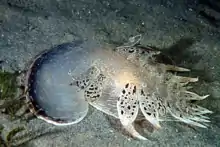 | |
| Tethys fimbria on the sand bottom shows its broad oral hood on the left (the head end) and the body with two rows of spotted cerata | |
| Scientific classification | |
| Kingdom: | |
| Phylum: | |
| Class: | |
| (unranked): | clade Heterobranchia clade Euthyneura clade Nudipleura clade Nudibranchia clade Dexiarchia clade Cladobranchia clade Dendronotida |
| Superfamily: | |
| Family: | |
| Genus: | |
| Species: | T. fimbria |
| Binomial name | |
| Tethys fimbria | |
| Synonyms[2] | |
|
Tethys leporina Linnaeus, 1758 | |
ICZN opinion 200 ruled that Tethys fimbria is a valid name and Tethys leporina Linnaeus, 1758 is a synonym.[2]
Distribution
The distribution of Tethys fimbria includes the Mediterranean Sea and the east coast of the Atlantic Ocean from Portugal in the north, to the Gulf of Guinea in the south.[3]
Description
The length of the body of Tethys fimbria can reach up to 30 cm (12 in).[3] Tethys fimbria is translucent, but it has dark spots on its cerata.[3] It has a broad oral hood in the frontal part of its body.[3] Rhinophores are small.[3] Tethys fimbria has no radula as is the case in all members of the family Tethydidae.[3]
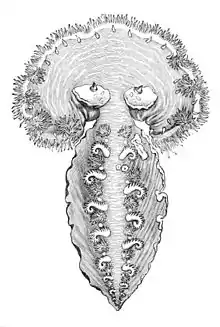 Drawing of dorsal view of Tethys fimbria, oral hood at the top of the image |
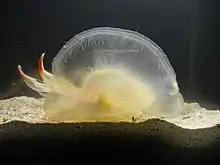 Underside view of oral velum. |
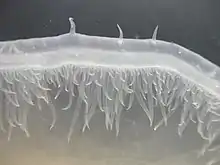 Photo of detail of frontal part of oral velum of Tethys fimbria from the ventral side |
Ecology
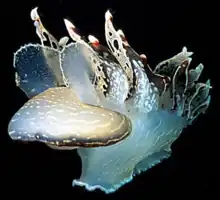
The habitat of Tethys fimbria is seas which have sand or mud on the bottom, in depths from 20 to 150 m.[3]
Tethys fimbria captures and feeds on small crustaceans.[3] It uses its broad hood for catching them.[3]
The cerata can be self-amputated (autotomy) as a defence mechanism when the slug is in danger.[3]
Within the mantle large amounts of prostaglandins are produced.[4] Subsequently the prostoglandins are moved to the cerata.[4] The biosynthesis of prostgandins has been studied by Marzo et al. (1991).[4]
References
- Linnaeus C. (1758). Systema Naturae, ed. 10, 653; 1767, ed. 12, page 1089.
- "Tethys fimbria Linné 1767 ". CLEMAM, accessed 29 December 2010.
- Rudman W. B. (14 October 2002) "Tethys fimbria Linnaeus, 1767 ". Sea Slug Forum, accessed 29 December 2010.
- Di Marzo, V.; Cimino, G.; Crispino, A.; Minardi, C.; Sodano, G.; Spinella, A. (1991). "A novel multifunctional metabolic pathway in a marine mollusc leads to unprecedented prostaglandin derivatives (prostaglandin 1,15-lactones)". The Biochemical Journal. 273 (Pt 3): 593–600. doi:10.1042/bj2730593. PMC 1149804. PMID 1899996.
Further reading
- Cattaneo-Vietti R., Chemello R., Giannuzzi-Savelli R. (1990). Atlas of Mediterranean Nudibranchs. La Conchiglia, Rome. 264 pp.
- Cimino, G.; Crispino, A.; Di Marzo, V.; Spinella, A.; Sodano, G. (1992). "Prostaglandin F-1,15-lactone fatty acyl esters: a prostaglandin lactone pathway branch developed during the reproduction and early larval stages of a marine mollusc". Comparative Biochemistry and Physiology B. 101 (1–2): 99–104. doi:10.1016/0305-0491(92)90164-M.
- Odhner N. H. (1936). "Nudibranchia Dendronotacea - A revision of the system". Memoires du Musee Royal d'Histoire Naturelle de Belgique, series 2, fasc. 3: 1057-1128. (Pl. 1)
- (in German) Schmekel L. & Portmann A. (1982). Opisthobranchia des Mittelmeeres. Nudibranchia und Saccoglossa. Springer-Verlag, Berlin. 410 pp., 36 plates.
External links
- "Tethys fimbria - Linnaeus, 1767". Marenostrum.org. Retrieved 30 June 2018.
- "Tethys fimbria - DORIS". Doris.ffessm.fr. Retrieved 30 June 2018.